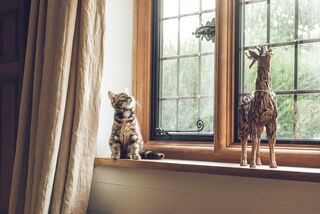Boredom
13 Research-Driven Ways to Make a Cat Happier
How can we keep indoor cats happy while minimizing any problem behaviors?
Posted June 7, 2020 Reviewed by Devon Frye
According to the American Veterinary Medical Association, cats living in suburban and urban areas should be kept indoors or enclosed outdoors given the numerous dangers of a free-roaming outdoor life. Free-roaming outdoor cats are vulnerable to cars, attacks from other animals, animal abuse, poison, traps, poor weather, and infectious disease. In addition, cats may negatively affect the existing ecosystem of the environment through their hunting.
This recommendation may be met with protests from both well-intentioned cat owners and their beloved pet cats. Keeping a cat indoors also comes with its own challenges. Cats may exhibit what we think of as “problem behaviors,” although some of these behaviors may be simply natural.
What can cat owners do then to keep their pets both safe and happy? Herron and Buffington (2010) provide 13 research-backed ways to keep indoor cats happy.

1. Create a “safe haven” for your cat. Most cats need a safe and quiet place to de-stress and keep away from “loud noises, dogs, other cats… and small children." Ideally, this safe haven would be soft and comfortable. The researchers suggest providing your cat with a spot where it can climb and perch high up to observe others.
2. Give your cat its own space. Many cat lovers understandably have several cats. When multiple cats are present, each cat should be given its own space—perhaps even its own room if possible. The researchers recommend giving cats the ability to stay at least 1-3 meters away from one another. Each cat should also be able to eat and eliminate separately and out of sight of the other cats, in a quiet spot. As such, each cat should have its own food bowls and litter box.
3. Make sure your cat stays hydrated. Cats sometimes need to be encouraged to drink water. While wet food is a good way to provide cats with hydration, some cats may need more water. If your cat isn’t interested in drinking water out of a bowl, try a water fountain as cats are naturally drawn to running water.
4. Use a large and open litter box. If your cat is picky about its litterbox, try one that is large and open, as it will allow your cat to engage in its natural behavior, including “pre-elimination digging, elimination posturing, and post-elimination digging and covering."
5. Place the litterbox in a quiet area away from food and water. Cats do not like eating where they eliminate, which is sensible and hygienic. They also do not like to be disturbed while eliminating.
6. Keep the litterbox clean and unscented. Cats enjoy cleanliness and are very sensitive to scents. Unscented litter should appeal to most cats. In addition, the litterbox should be cleaned on a regular basis. The researchers recommend scooping the box each day, emptying the box each week, and washing the box each month. Self-cleaning litter boxes may be appealing in their cleanliness, but skittish cats may be scared off by their noises.
7. Do not force your cat to interact with you. Most cats do the best when they feel in control of a situation. To earn your cat’s trust, allow your cat to choose when and how they want to interact with you.
8. Place scratching posts in areas where the cat likes to rest. To keep cats from scratching your favorite furniture, place scratching posts in places where the cat likes to rest and sleep, as this is where cats typically engage in scratching.

9. Provide non-toxic plants for your cat to chew on. Like scratching, chewing is a normal cat behavior and is in no way a sign of unhappiness. However, it is often problematic from a cat owner’s standpoint. To discourage undesirable chewing, give your cat non-toxic plants or grass to chew on. You can rub wet cat food on the plant to encourage chewing. Some cats also enjoy chewing on jerky.
10. Encourage your cat to “hunt” using puzzle toys. To keep indoor cats engaged and physically active, you can give them puzzle toys which feed the cats as they explore them.

11. Rotate toys to keep your cat interested in playing. Cats can get bored with the same toys. The researchers encourage rotating toys to keep their experience novel. Suggested toys are “wand toys, battery-operated self-propelling toys that mimic prey, balls inside a box or bathtub, catnip-filled toys, and light-beam pointer games." The researchers recommend providing your cat with a treat after playing with a light-beam pointer game so that it does not become frustrated.
12. Do not use your own body parts to “play hunt” with your cat. Many people like to play hunt with their kittens using their hands and fingers, because it is just so darn cute. However, this may quickly backfire on a cat owner when the kitten learns that body parts are an ideal target. Inadvertently, the cat owner has trained their pet to be aggressive towards humans.

13. Give your cat something fun to watch. Cats love to quietly observe their environment, especially from high up. A window perch may provide your cat with entertainment. Some cats even enjoy watching videos of birds and little creatures. Given the proper space, cat owners can consider building a “catio” to give their cat a safe place to play outside.
There is an undeniable feeling of sadness when a cat lover envisions their cat longing for the outdoors. Most cats, however, can be happy living inside with time, effort, and patience.
Facebook image: PHOTOCREO Michal Bednarek/Shutterstock
References
Herron, M. E., & Buffington, C. T. (2010). Environmental enrichment for indoor cats. Compendium on Continuing Education for the Practicing Veterinarian, 32, E4.




